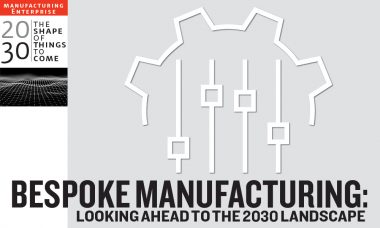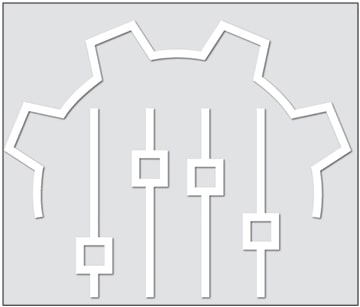Bespoke Manufacturing: Looking Ahead to the 2030 Landscape

Customized manufacturing is what customers demand, but getting there requires building a connected end-to-end value chain.
By Shruti Gupta, Jason Alexander and Ron Beck
Advanced technologies have already made their way into industrial supply chains across the globe, transforming all aspects of production and labor. Now, looking forward over the next decade, manufacturers should prepare for a future where customers are increasingly focused on speed, personalization and customization, requiring them to have greater agility and flexibility in order to compete in this new consumer-driven world.
As factories and plant operations become increasingly smarter and automated, and with the increased implementation of 5G, quantum computing and other advanced technologies, manufacturers will be able to take greater advantage of Internet of Things capabilities. This will allow their supply chains to become more streamlined and direct, opening the door for more tailor-made offerings. To take advantage of this shift, companies should start assessing now how they may need to pivot their products and services to thrive in a future in which customization will be key.
We expect the growing prevalence of microfactories around the United States to be of core importance for this vision of the future of manufacturing. By having a greater number of smaller production facilities closer to end-market customers, companies will be able to dramatically reduce the time it takes to get products from inception to the consumer’s doorstep, even when factoring in time for customization. 5G, robotics, artificial intelligence and other highly connected technologies will make all of this possible. As these technologies advance, the end game for many manufacturers will be lights-out microfactories, run remotely with no human presence.
This future of consumerization will require manufacturers to be proactive rather than reactive. Over the next decade, manufacturers will not simply need to examine their value chains to see where new technologies might fit; rather, they will need to redevelop the value chain and operational systems with the end user in mind, based on what advanced technologies make possible.
All of this might seem daunting, especially for companies that are not as far along in their journeys to integrate advanced technologies across their value chains. Below, we examine some of the most important areas businesses should focus on to position themselves for success in this era of bespoke manufacturing.
Microfactories: Streamlining Production
As manufacturers leverage technology in their processes and supply chains, we expect a more widespread adoption of “lights out” microfactories – completely autonomous and smaller facilities that can help companies save resources, space and the amount of time it takes to get the final product to the consumer, while also supporting the growth of regional manufacturing innovation hubs.
Here’s an example of what this might look like by the end of the decade: A customer could use a mobile app to order a customized automobile, with specifications from the engine to the tires to the color of the lights in the dashboard. That order then launches the production process at whichever one of the company’s microfactories is closest to that customer. The entire process is automated, using additive manufacturing, advanced materials and advanced robots, and can be monitored from anywhere in the world, requiring no human intervention on-site.

Companies should assess now how they may need to pivot their products and services for a future in which customization is key.
Smart technologies will allow delivery from these microfactories to be more automated and streamlined as well – for instance, a company might use an autonomous vehicle to transport the customer to the microfactory to pick up their vehicle, or use an advanced robot to deliver the automobile directly to the consumer. This allows the business to deliver the product on a compressed timeline that has never before been a possibility.
The Connected Digital Infrastructure
The future holds a completely connected end-to-end value chain with a two-way information exchange supported by powerful communication networks. A robust infrastructure foundation driven by advanced technologies can enable companies to facilitate real-time interactions between factory locations. This allows for greater efficiency, more nimble operations and faster response times for production issues. For instance, companies will be able to anticipate demand disruption earlier, allowing information systems to autonomously check inventories, modify production, and alter pricing and delivery schedules to ensure there is no supply glut and maintain customer expectations.
This is the power of connectivity across factories, markets and logistics, and cloud-based capabilities are central to realizing these possibilities. Cloud technology allows manufacturers to better monitor inventory, supply chains, backlogs, manufacturing schedules, delivery logistics, and other facets of the production cycle in order to provide customers with real-time information throughout the process. The cloud also provides easy access to data that can be shared with partners, which can dramatically shorten the time required to produce tailor-made goods; the era of waiting weeks for a custom product is coming to an end. This use of data can also provide the customer with greater visibility into a process uniquely tailored to them.
The growing adoption of 5G networks is also transforming businesses’ digital capabilities, making once-novel technologies such as Internet of Things devices, 3D printing and robotics more and more commonplace. Companies should constantly seek out new ways to implement these technologies as they evolve and tap into the potential these newer applications have for streamlining customized production.
With powerful connectivity and machine learning advancements, decentralized and autonomous technologies will make processes faster and more efficient. While plenty of questions remain about what this continued evolution of technology will mean for the role of humans in the workforce, we expect machines and workers to continue to have a symbiotic relationship.
The Digital Mandate
These future scenarios will only be possible if manufacturers embrace technologies such as 3D printing, 5G connectivity, automation, artificial intelligence and machine learning. The consumerization of manufacturing will require manufacturers to shift their mindsets and prioritize customer engagement metrics. Companies will need to center innovation and technology in their business strategy with intention, rather than leaving them as an afterthought. The future holds limitless promise for manufacturing, provided companies are ready to adapt. M
FOOTNOTES
1 Niall McCarthy,” Rise of the Machines: The Countries with the Highest Density of Robot Workers,” Forbes, Sep 28, 2020, https://www.forbes.com/sites/niallmccarthy/2020/09/28/rise-of-the-machines-the-countries-with-the-highest-density-of-robot-workers-infographic/amp
2 Ibid.
3 Emil Protalinski, “Boston Dynamics CEO talks profitability and the company’s next robots,” Venture Beat, Sep 14, 2020, https://venturebeat.com/2020/09/14/boston-dynamics-ceo-profitability-roadmap-next-robots/
4 Manufacturing Leadership Council, “Vision 2020: The Factory of the Future,” 2017. https://www.mljournal-digital.com/meleadershipjournal/ february_2017? pg=25#pg25
5 Art Markman, “How You Define the Problem Determines Whether You Solve It,” Harvard Business Review, June 6, 2017, https://hbr-org.cdn.ampproject.org/c/s/hbr.org/amp/2017/06/how-you-define-the-problem-determines-whether-you-solve-it
6 Manufacturing Leadership Council, “Vision 2020: The Factory of the Future,” 2017.
7 Niall McCarthy,” Rise of the Machines: The Countries with the Highest Density of Robot Workers,” Forbes, Sep 28, 2020, https://www.forbes.com/sites/niallmccarthy/2020/09/28/rise-of-the-machines-the-countries-with-the-highest-density-of-robot-workers-infographic/amp/[/et_pb_text][/et_pb_column][/et_pb_row][/et_pb_section]